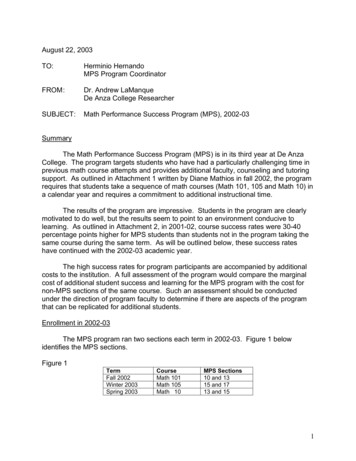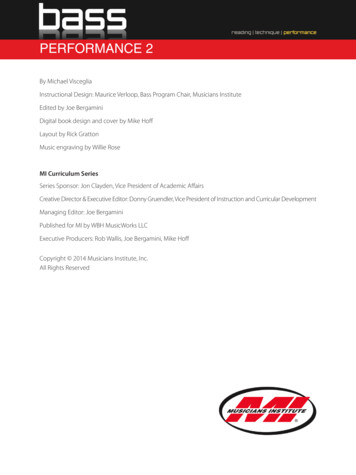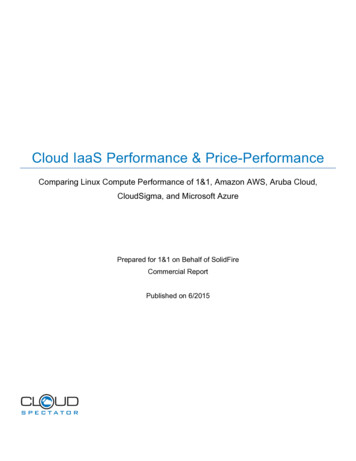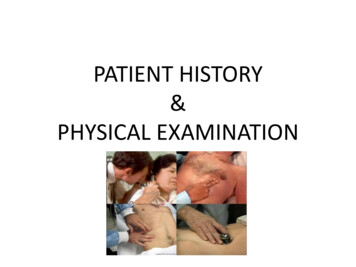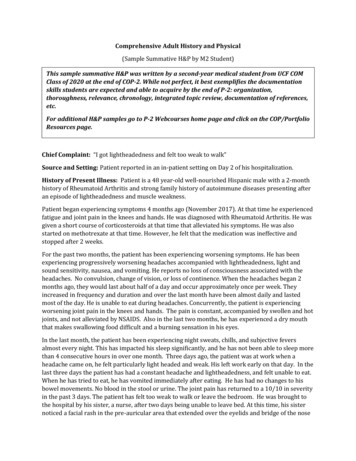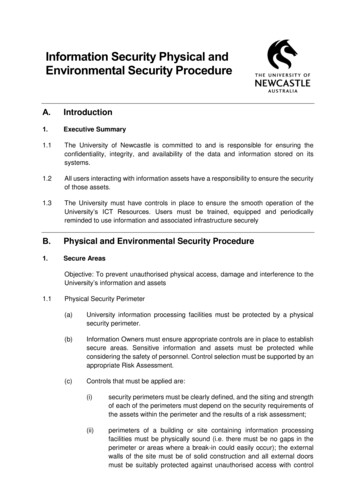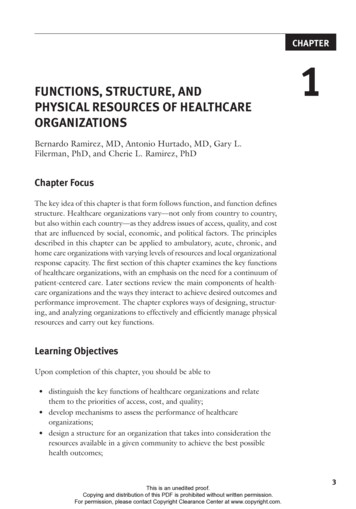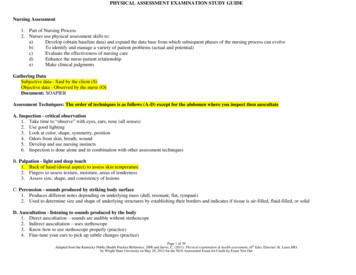
Transcription
jADA24 5 72.9U.S. Army Research Institutefor the Behavioral and Social SciencesResearch Report 1606Physical Performance Predictors ofSuccess in Special Forces Assessmentand SelectionMartha L. TeplitzkyU.S. Army Research InstituteS-k'DJAN29 1November 1991Approved for putlic release; distribution is unlimited.92-02181
U.S. ARMY RESEARCH INSTITUTEFOR THE BEHAVIORAL AND SOCIAL SCIENCESA Field Operating Agency Under the Jurisdictionof the Deputy Chief of Staff for PersonnelMICHAEL D. SHALERCOL, ARCommandingEDGAR M. JOHNSONTechnical DirectorTechnical review byElizabeth BradyHenry H. BusciglioNOTICES/lISTUrI Primatributo this rehbeendey ARI-.addressIrspoeeAL DISPOSITION: This report may be destryed when it is no longer needed. Please do not return it tothe U.S. Army Research Institute for the Behavioral and Social Sciences.NOTE: The findings in this report are not to be construed as an official Department of the Annmy position,unless so designated by other authorized documents.
YLASSIFICATION OF THIS PAGEFormApprovedREPORT DOCUMENTATION PAGEta. REPORT SECURITY CLASSIFICATIONOM8 No. 074.0o7881b. RESTRICTIVE MARKINGScnclassified-- .3. DISTRIBUTION IAVAILABILITY OF REPORT2a. SECURITY CLASSIFICATION AUTHORITY.Approved for public release;distribution is unlimited.2b. DECLASSIFICATIONI DOWNGRADING SCHEDULES. MONITORING ORGANIZATION REPORT NUMBER(S)4. PERFORMING ORGANIZATION REPORT NUMBER(S)ARI Research Report 16066b. OFFICE SYMBOL(If applicable)6a. NAME OF PERFORMING ORGANIZATIONU.S.Army Research InstitutePERI-RPI--7b. ADDRESS (City, State, and ZIP Code)6c. ADDRESS (City, State, and ZIP Code)5001 Eisenhower AvenueAlexandria, VA 22333-5600--.'Ba. NAME OF FUNDING /SPONSORI\ORGANIZATION U. S. Army7a. NAME OF MONITORING ORGANIZATIONResearchInstitute for the Behavioraland Social Sciences8b. OFFICE SYMBOL(If applicable)PERI-R9. PROCUREMENT INSTRUMENT IDENTIFICATION NUMBER10. SOURCE OF FUNDING NUMBERSTASKPROJECTPROGRAMNO.NO.ELEMENT NO.Sc. ADDRESS (City, State, and ZIP Code)5001 Eisenhower AvenueAlexandria, VA 22333-5600S.63007A.2224792WO UN ITACCESSION NO.221ZZ4IHul11. TITLE (Include Security Classification)Physical Performance Predictors of Success in Special Forces Assessment and Selection12. PERSONAL AUTHOR(S.Teplitzky, Martha L.13a. TYPE OF REPORTFinal13b. TIME COVEREDFROM 88/10TO91/0614. DATE OF REPORT (Year, MonthDay),, ,,1991,November15. PAGE COUNTC,,16. SUPPLEMENTARY NOTATIONThe research described in this report is the result of a collaborative effort by ARI andthe John F. Kennedy Special Warfare Center and School at Fort Bragg, NC17.FIELDCOSATI CODESSUB-GROUPGROUP18. SUBJECT TERMS (Continue on reverse if necessary and identity by block number)Army physical fitness testPhysical performanceSpecial forces assessmentRuckmarch19. ABSTRACT (Continue on reverie if necessary and identify by block number)'-----ý.This research examines the relationship between scores on two physical performancemeasures--the Army Physical Fitness Test (APFT) and a Ruckmarch administered early in theThe sample consisted of candidatesSpecial Forces Assessment and Selection (SFAS) program.from the 25 SFAS classes conducted in FY89 (n 2059), FY90 (n 2074), and FY91 (first 8Only candidates who met all SFAS prerequisites and were present forclasses only, n 1863).the first SFAS event were included in the analysis sample.Results indicated that APFT scores had an average correlation of r .25 with success inAnalyses designed tothe program, and the Ruckmarch had an average correlation of r .43.that increasingsuggestedassess the utility of various APFT and Ruckmarch cut-off m Ruckmarch scores would be aneliminating potentially successful candidates.4----.-.20. DISTRIBUTION /AVAILABILITY OF ABSTRACT0 SAME AS RPT.Q UNCLASSIFIED/UNLIMITED22a. NAME OF RESPONSIBLE INDIVIDUALNora K. StewartDD Form 1473. JUN 9621. ABSTRACT SECURITY CLASSIFICATION0DTIC USERSUnclassified22b.TELEPHONE (Include Area Code) 22c. OFFICE SYMBOL(703)Previouseditionsare obsolete.274-8119PERI-RPSECURITY CLASVIFICATION OF THIS PACEUNCLASSIFIED
Research Report 1606Physical Performance Predictors of Success in SpecialForces Assessment and SelectionMartha L. TeplitzkyU.S. Army Research InstitutePersonnel Utilization Technical AreaPaul A. Gade, ChiefManpower and Personnel Research LaboratoryZita M. Simutis, DirectorU.S. Army Research Institute for the Behavioral and Social Sciences5001 Eisenhower Avenue, Alexandria, Virginia 22333-5600Office, Deputy Chief of Staff for PersonnelDepartment of the ArmyNovember 1991Army Project NumberManpower and Perscnnel20263007A792Approved for public re'ease; distribution is unlimited.iii
FOREWORDThe research described in this report is the result of acollaborative effort by the U.S. Army Research Insticute for theBehavioral and Social Sciences (ARI) and the John Y. KennedySpecial Warfare Center and School at Fort Bragg. North-Carolina.The work was completed as part of the Personnei UtilizationTechnical Area's work directive that covers research designed toassist in the identification, recruitment, assessment, selection,and utilization of Special Forces personnel.The complexity of Special Forces missions throughout theworld and the increasing need for highly qualified personnel tomeet Special Forces manpower requirements mandate a heightenedresearch focus on the assessment and selection of personnel.ARI's commitment to provide this kind of research support isdocumented in a June 1991 Memorandum of Agreement between theU.S. Army Special Operations Command (USASOC) and ARI.This research focuses on the relationship between earl,indicators of physical fitness and endurance in the SpecialForces Assessment and Selection (SFAS) program and ultimatesuccess in SFAS.Results indicate that performance on aRuckmarch test administered early in the program is a strongpredictor of overall success in the program.The reportdiscusses the implications of the findings for efforts to enhancethe quality of Special Forces volunteers and increase thepercentage of successful candidates.The results of this research have been briefed to theSpecial Warfare Center and School and have been used as the basisfor a new initiative (a pre-SFAS Physical Training Handbook) toattract highly motivated, physically fit volunteers to SpecialForces.Research to evaluate the utilityof the PhysicalTraining Handbook will be part of ARI's Special Forces researchprogram for FY92.Aceonaion ForNTIS GRA&IEDGAR M.DTIC TABUnannouncedJustifioatioOHNSONTechnical DirectorI]ByDstributlwiDIrAvailability CodesIIvSil an"/orDistSpecialvv-
ACKNOWLEDGMEN-TSThe contributions of the folliuirg individuals from the JohnF. Kennedy Special Warfare Center and School are gratefullyacknowledged:Colonel Ernest Lenz (Chief Psychologist)Lieutenant Colonel Steve Wright (former Commander 1stBattalion, 1st Special Warfare Training Group)Lieutenant Colonel Dave McCracken (current Commander, 1stBattalion, 1st S'-cial Warfare Training Group)Colonel Travis Griffin (Chief of Staff)Ms. Doe Ann Keene (statistician, Directorate of Evaluationand Standardization)Master Sergeant Butler (NCOIC,Standardization)viDirectorate of Evaluation and
PHYSICAL PERFORMANCE PREDICTORS OF SUCCESS IN SPECIAL FORCESASSESSMENT AND SELECTIONEXECUTIVE SUMMARYRequirement:The John F. Kennedy Special Warfare Center and School (SWCS)at Fort Bragg, North Carolina, conducts the Special ForcesAssessment and Selection (SFAS) program and Special Forcestraining. The staff at the Special Warfare Center requires dataon factors associated with success in SFAS to mase decisionsabout screening criteria and potential changes in assessmentprocedures and standards.The U.S. Army Research IJstitute forthe Behavioral and Social Sciences (ARI) conducted this researchto address specific questions raised by SWCS staff about "'ysicalperformance in SFAS.Procedure:The Special Warfare Center maintains a personnel andperformance database on SFAS candidates.Data from the 25 SFASclasses conducted between October 1988 and June 1991 wereprovided to ARI for this research.Correlational analyses weresupplemented by analyses examining SFAS success rates withincategories defined by scores on the Army Physical Fitness Test(APFT) administered at Fort Bragg and scores on the firstRuckmarch event in SFAS.Findings:The Ruckmarch was a better predictor of success in SFAS thanthe APFT, with an average correlation across 3 fiscal years of.42.The sel3'ct rate and cut-off analyses also suggested thatselect rates could be improved with a minimal loss of potentiallysuccessful candidates if the 10 percent of the candidates in thepoorest Rucknarch performance category could be eliminated fromSFAS.In contrast, stricter screening standards on the APFTwould increase the overall select rate only slightly andeliminate a greater proportion of candidates who would probablysucceed in SFAS.vii
Utilization of Findings:The results suggest that effort to raise the minimum oraverage Ruckmarch performance level of incoming SFAS candidateswould lower assessment costs and increase select rates.Preliminary findings from this research prompted the SpecialWarfare Center, Special Forces recruiters, and ARI to design aThe utility of thispre-SFAS Physical Training Handbook.handbook for increasing the fitness level of SFAS candidates willbe evaluated by SWCS and ARI in FY92.viii
PHYSICAL PERFORMANCE PREDICTORS OF SUCCESS IN SPECIAL FORCESASSESSMENT AND SELECTIONCONTENTSPage.Background . .Purpose. . . . . . . . . . .*. .INTRODUCTION.1.1I.2.2Sample . . . . . . . . . . . . . . . . . . . . . . . . .2METHOD.Measures.0. . .*.*3.4and Correlational AnalysesDescriptive StatisticsScore Distributions and Select Rate Analyses . . . . . . . . . . . .Hypothetical Cut-Off Analyses.*.4711RESULTS . .DISCUSSION.REFERENCES.APPENDIX:. . .18. .21PROJECTED RESULTS WITH DIFFERENT APFTAND RUCKMARCH CUT-OFF SCORES FOR FY89AND FY90 . .A-1.6.6LIST OF TABLESTable 1.Descriptive statistics and correlationsby fiscal year for candidates with APFTof 206 or more2. .SFAS FY 91:.Projected results withdifferent APFT cut-off scores4.Grad and non-grad means on physicalperformance variables .3.SFAS FY 91:.13.15Projected outcomes withhigher APFT cut-off scoresix.
(r. atinued)PageTable S.6.Projected results withSFAS FY 91:different Ruckmarch cut-off scores. . . . . . .16SFAS FY 91:Projected outcomes withRuckmarch cut-off scores . . . . . . . . . . . .17LIST OF FIGURESFigure 1.2.3.4.5.SPAS FY89-PY91: Final outcomes forcandidates present for first SFAS event(Day 4) . . . . . . . . . . . . . . . . . . . .5SFAS FY89-PY91: Distribution of APFTscores . . . . . . . . . . . . . . .8SFAS FY99-FYPI: Select rates withinAPFT groups. . . . . . . . . . . . . . . . . .9SFAS FY89-FY91:Distribution of Ruckmarchscores . . . . . . * . . . . . . . . . . . . . .10SFAS FY89-PY91; Select rates withinRuckmarch groups . . . . . . . . . . . . . . . .12x
PHYSICAL PERFORMANCE PREDICTORS OF SUCCESS INSPECIAL FORCES ASSESSMENT AND SELECTIONIntroductionSpecial Forces (SF) soldiers are distinguished by manycharacteristics, among them, their physical endurance and everpresent ruckeacks.Deploying without the logistical supportavailable to conventional forces, Special Forces soldiers carryon their backs what they need to survive and fight. A fullyloaded operational rucksack can easily weigh up to 100 pounds,and for many missions this load must be carried long distancesover difficult terrain.Physiological research suggests thatSpecial Forces soldiers are the most physically fitin the Army,particularly with respect to lean body mass and aerobic fitness(Muza et al., 1987).Yet, even for this highly conditioned groupof soldiers, Ruckmarches are reported to be the most physicallydemanding tasks performed on the job (Army Occupational SurveyProgram, 1988).Any program to select Special Forces soldiers needs to takeinto account the strength and endurance requirements of the job.The ability to meet Army physical fitness standards does not,alone, indicate that a soldier is fit to perform physicallydemanding tasks over a long period of time (Dewulf, 1987).Lightinfantry soldiers, for example, experienced difficulty bearing 42pound (average) loads during a five day continuous operationsscenario that began with a 10-mile road march (Army PhysicalFitness Research Institute, 1984).The types of injuriessustained (lower back pain, muscle spasms) and field observationsindicated that soldiers were not adequately conditioned forwalking long distances while bearing a basic combat load.Thisis typical of the Army at large, where loads required in combattypically exceed both recommended standards and what soldiershave been trained to carry (Buckalew, 1990).Physical conditioning is clearly an important determinant ofa soldier's ability to carry heavy loads.Upper and lower bodystrength and endurance, leg strength and endurance, balance, andaerobic fitness are all physical components of load bearingperformance (Buckalew, 1990).Psychological factors, however,particularly motivation, are equally important (Buckalew, 1990).Motivation determines whether or not a soldier quits or carrieson when he is reaching his physical limits.Motivation, combinedwith self-discipline, is also likely to determine the extent towhich a soldier trains to build the strength and endurancerequired to carry heavy loads.From an assessment perspective, the challenge faced by theU.S. Army John F. Kennedy Special Warfare Center and School(USAJFKSWCS) is to design tests or events that measure both thephysical and the psychological attributes required for successful
performance.In order to meet this challenge, the 21-day SpecialForces Assessment and Sele
U.S. Army Research Institute Personnel Utilization Technical Area Paul A. Gade, Chief Manpower and Personnel Research Laboratory Zita M. Simutis, Director U.S. Army Research Institute for the Behavioral and Social Sciences 5001 Eisenhower Avenue, Alexandria, Virginia 22333-5600 Office, Deputy Chief of Staff for Personnel Department of the ArmyCited by: 2Publish Year: 1991Author: Martha L Teplitzky


